Multi conversions
Multi conversion anything that you want to convert from http://www.unitconversion.org/
with free download tools conversion version 5.1, all you have to do is click below or input.
1. distance and length conversion
2. weight and mass conversion
3. currency conversion
4. capacity and volume conversion
5. volume - dry conversion
6. temperature conversion
7. area conversion
8. pressure conversion
9. energy and work conversion
10. power conversion
11. force conversion
12. time conversion
13.velocity conversion,
14.angle conversion,
15.fuel consumption conversion,
16a.numbers conversion,
16b. data storage conversion,
17.velocity - angular conversion,
18.acceleration conversion,
19.acceleration - angular conversion,
20.density conversion,
21.specific volume conversion,
22.moment of inertia conversion,
23.moment of force conversion,
24.torque conversion,
25.fuel efficiency - mass conversion,
26.fuel efficiency - volume conversion,
27.temperature interval conversion,
28.thermal expansion conversion,
29.thermal resistance conversion,
30.thermal conductivity conversion,
31.specific heat capacity conversion,
32.heat density conversion,
33.heat flux density conversion,
34.heat transfer coefficient conversion,
35a.flow conversion,
35b.flow - mass conversion,
36.flow molar conversion,
37.mass flux density conversion,
38.concentration - molar conversion,
39.concentration - solution conversion,
40.viscosity - dynamic conversion,
41.viscosity - kinematic conversion,
42.surface tension conversion,
43.permeability conversion,
44.sound conversion,
45.luminance conversion,
46.luminous intensity conversion,
47.illumination conversion,
48.digital image resolution conversion,
49.frequency wavelength conversion,
50.charge conversion,
51.linear charge density conversion,
52.surface charge density conversion,
53.volume charge density conversion,
54.current conversion,
55.linear current density conversion,
56.surface current density conversion,
57.electric field strength conversion,
58.electric potential conversion,
59a.electric resistance conversion,
59b. electric resistivity conversion
60a.electric conductance conversion,
60b.electric conductivity conversion
61.electrostatic capacitance conversion,
62.inductance conversion,
63.magnetomotive force conversion,
64.magnetic field strength conversion,
65.magnetic flux conversion,
66.magnetic flux density conversion,
67a. radiation conversion
67b.radiation - activity conversion
68.radiation - exposure conversion
69.radiation - absorbed dose conversion
70.prefixes conversion
71.data transfer conversion
72.EU currency conversion
73.typography conversion
74.volume - lumber conversion
A dictionary of unit measurement - complete information on a specific unit alphabetical order.
free pdf file for symbol and conversions factors
conversions - mass, length, volume/capacity, area, mass density,linear density, surface density, time, force, energy, heat and work, power.















